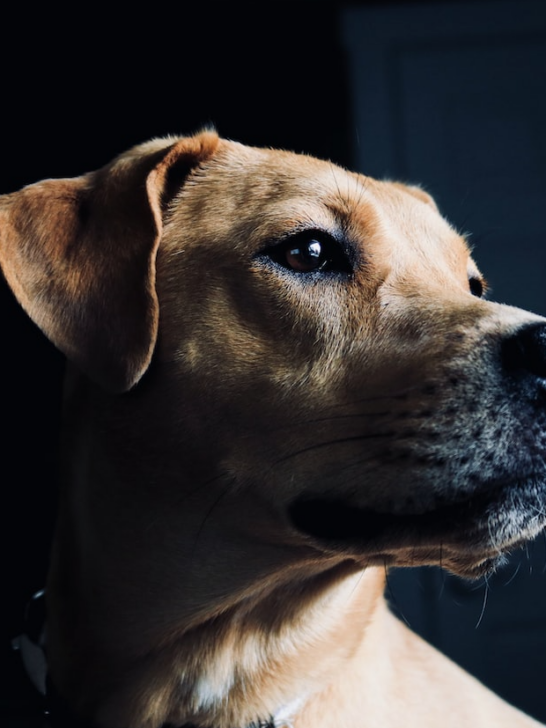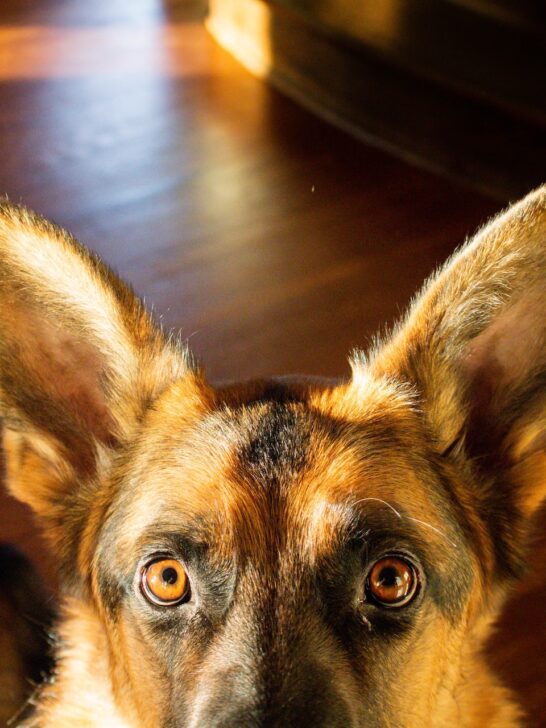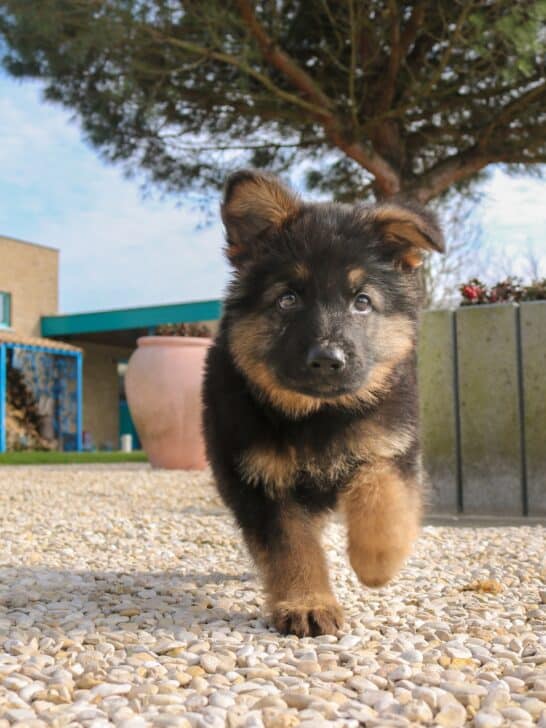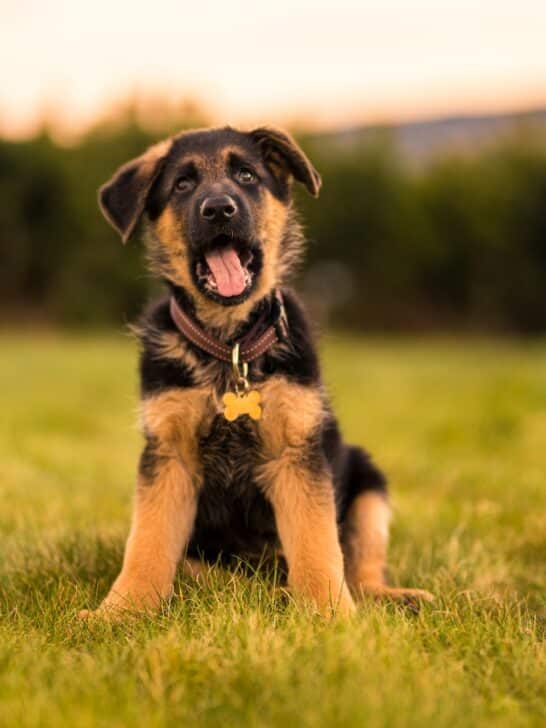How to Crate Train a German Shepherd Puppy? The Best Methods
Leaving your dog in its crate for an extended period of time may fill you with guilt at first.
But If you take the time to properly crate train your puppy, you will see that it’s not so bad after all!
Crate training your German Shepherd as a puppy will involve a few simple steps:
- Choosing the appropriate size and type of crate
- Introducing it to your pup
- Establishing a command
- And acclimating your pet to its kennel
You can utilize different methods of crate training, such as a combination of treats, games, and toys.
The ultimate goal of a well-trained puppy is having the ability to use crates for road trips, flights, temporary separation from other pets, and potty training.
Like any other skill you teach your dog, crate training your German Shepherd puppy centers around consistency and a positive reward system.
Think of your pup’s time spent in the crate not as a jail sentence, but as an alternative type of haven, or safe place just for them.
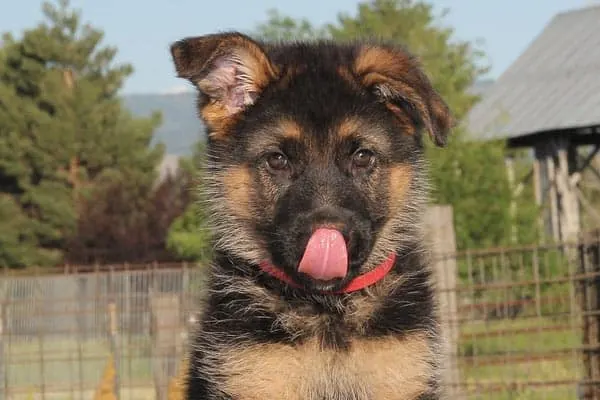
How Did Crate Training Dogs Evolve?
A few pragmatic people probably thought about the concept of dog crates simultaneously.
Some of the earliest dog crates were wooden and found use during World War II to transport working dogs.
When they appeared in the 1940s, crates were convenient to ship dogs overseas as well as by rail.
Historians believe crating dogs for convenience was a concept that may have begun in the United States in the 1950s.
At least one company adopted the idea of dog shipping crates from people who were using wire garbage bins as makeshift doghouses.
The company modified these trash burning receptacles into carriers that could house dogs.
Around 1962, Doxel* proposed a pet carrier design that would change the animal shipping crate industry forever. (*link removed)
Carriers would develop safety features and improve durability from the original crates the airline carriers used to transport people’s pet dogs safely.
By 1968, the airlines moved from wooden crates to plastic.
The pet crate became a staple of dog owners’ homes as companies began to market the concept of pooches having denning instincts in the 1970s.
Crates were to serve a dog’s needs for a small, closed-in space.
As scientific discovery progressed, the truth behind whether dogs were denning animals at all came under scrutiny.
Although feral dog studies debunked the concept that domesticated canines are den dwellers and other imagined similarities to wolves, experts never truly released the public’s hold on this romantic belief.
Pet kennels in America exploded in the 1980s as celebrity professionals illustrated the crate’s use as a training tool.
Dog crates are vital in the United States for everything from house training to behavior medication in addition to shipping and transportation.
However, other places around the world do not look at dog crates the same.
Although there are surely exceptions for flying your dog, some European countries ban dog crates, and groups like PETA cite them as cruel and abusive.
Nevertheless, dog training is the glue that makes crates desirable for your German Shepherd.
In a fast-paced society, crates are sometimes the only thing that stands between a potentially destructive dog and the animal shelter.
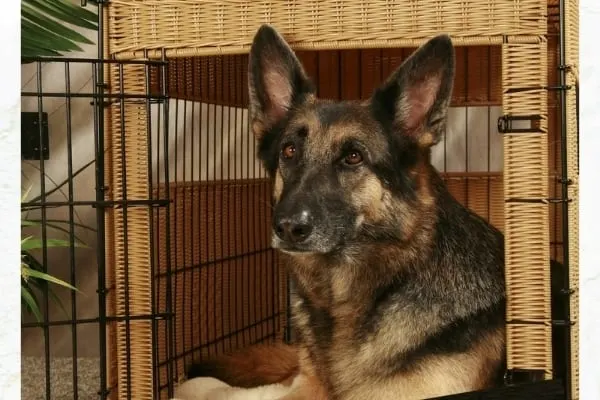
Why Must You Crate Train Your German Shepherd Dog?
There are several reasons you should incorporate crate training as an essential part of your German Shepherd’s education.
- Speeds up house training – Trains your dog to “hold it” as most will avoid soiling themselves.
- Provides your dog her own space to which she can retreat
- Can use for car rides, especially when traveling in the back of a truck or SUV
- The only way to transport large dogs by airlines – Early training your puppy early will alleviate anxiety when circumstances force you to use a dog crate.
- Prevents puppies from chewing on unwanted household items when you cannot supervise them.
- Can train behaviors like calmness, independence, restraint, and self-assurance.
- Time out for dogs – If your dog is fighting with a housemate, the children are relentless, or you are not sure how he will do with a particular houseguest, a crate is a good place for him to wind down or chill.
- Introducing your German Shepherd safely to other household pets
You might remark to yourself that you already know the obvious reasons to crate train your dog. You could further ask, “Why train her at all? Don’t dogs like to be in a kennel?”
You might subscribe to the notion that dogs are inherently den animals because many sources tell you it is in the canid’s DNA.
However, you recognize that crates with their doors are substantially different from caves and dens.
You must train your dog that a kennel is a secure and enjoyable place to be despite the fact it deprives her of freedom and control over her environment.
How Do You Crate Train a German Shepherd Puppy?
First, choose the right dog crate
Size
You can approach size in a few different ways.
- One crate that you use to house train your puppy and get rid of it when your dog becomes an adult.
- A crate for your puppy and subsequent crates as your dog outgrows them
- A large crate that fits what you anticipate your dog’s adult size will be – You use a crate that has dividers equipped or compartmentalizes your kennel to your pup’s size using handy items like cushions, blankets, or cardboard.
The size of your pup’s crate is most important when you are housebreaking her.
She should be able to stand up, turn, and lay down comfortably, but you do not want her to have sufficient room to go to the bathroom in a corner.
To cater a crate to your puppy’s size, measure your pet when she is sitting for the height of the kennel.
Add six inches to your final measurement from the top of your dog’s head to the floor.
Then as she stands, measure from her nose to the end of her pelvis to get the crate’s length. Again, add five or six inches.
Once you have house trained your German Shepherd, you can be more generous in the amount of space she has in her kennel.
Style
Style is not only a consideration for aesthetics but also involves practical concerns.
- Material – Plastic and metal are more durable than soft-sided crates; Consider regulation materials and dimensions for flying if applicable; Nylon and mesh material can be difficult to clean but are more portable; Wood and wicker are decorative but easy to damage
- Color – Only important to you; Color selections may be nonexistent with metal crates
- Cover – Whether you choose to cover your dog’s crate depends on your puppy. Do not expect your pup to seek to hide automatically, but some develop a preference for covered crates.
- Portability – If you will use your dog’s crate for transport, the hard plastic ones may have crash ratings but take up a lot of space. Many metal crates fold into a convenient single layer that fits under your bed. Soft crates fold up nicely but may not offer much protection in the event of a collision.
Additional tips to take under advisement are to design your crate more around your puppy’s needs than to your sense of style.
Plastic carriers are among the most versatile and affordable options. They offer decent coverage for dogs who need a more closed-in crate to feel comfortable.
A plastic carrier still has several openings for your pup to see everything. Moreover, it is fairly easy to clean and maintain, although plastic can retain odors from urine.
Metal crates are another popular choice. They are extremely durable and offer your dog a completely unobstructed view of her environment.
For dogs who prefer a more hidden feel, you can cover the crate with a sheet or blanket. A cover plus a blanket and pillow inside will help with insulation.
Soft carriers are not the ideal option when attempting to housebreak puppies.
Moreover, German Shepherds are large and active puppies who can easily destroy soft-sided crates. As your puppy grows, the size of the crate may cause it to collapse onto your pet.

Find a couple of suitable spots for your German Shepherd’s crate
You can select a couple of spots to put your dog’s crate depending on whether it is day or night.
During the night your puppy should be near where you are sleeping.
In your bedroom, just outside your room, or next to your bed, are excellent places for a crated puppy.
You want to be nearby when your puppy wakes up to urinate and to keep an ear out for signs of distress.
When you awake for the day, move your pup’s crate to an out-of-the-way corner that is still at the center of household activities.
Many people choose near the kitchen or dining room.
Not far from an exit door is a good choice, also, so you can quickly take your puppy outside as necessary.
Make sure your pup’s crate is not in a pathway where people will bump into it or have to step over it.
However, you want your puppy to feel a worthwhile and participating member of the household, including when he is in his kennel.
At the same time, your pup should be able to sleep as he chooses peacefully.
Bring a positive attitude
The most effective way to teach a puppy or dog any skill is to make your pet look forward to it.
You will win half the battle just by bringing enthusiasm to the training session.
Your puppy is naturally social and will take her cues from your energy.
One of the greatest challenges may be to alter your perspective on crating dogs. Sometimes your conscience may say you are torturing your dog by locking him up.
Media and activist viewpoints often feed emotional but not necessarily objective concerns about pet crates, according to renowned dog psychologist Stanley Coren.
Dogs do not have the same view of confinement as people.
Generations of careful selection created a puppy who will depend on you and care more about your company and attention than periodic restrictions.
If you provide sufficient exercise for your active German Shepherd as well as food, quality attention and affection, mental enrichment, a positive experience with the crate, and a job to perform, your dog will grow accustomed and happy to spend time in his kennel.
As with any type of training, be patient. According to the AKC, crate training may take up to six months or more.
German Shepherds are very intelligent, but dogs are like people and learn in a series of forwarding progressing steps and small reversals.
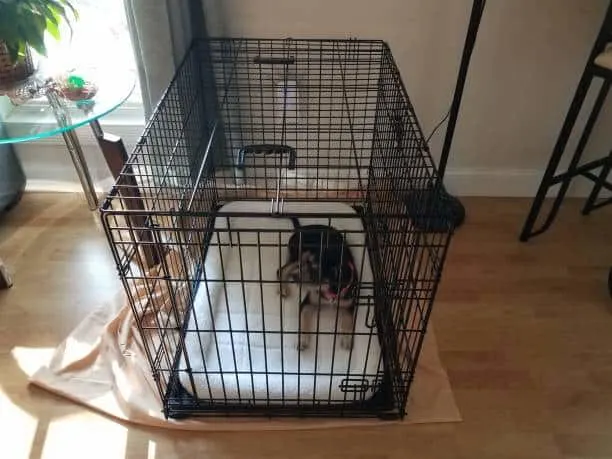
Find crate training methods that work best for your puppy
Different crate training methods center around the reward system. You can combine more than one method as that seems most effective.
Remember to select a command that encourages your pup to enter his crate.
Always state the command before your pet goes in, and once he steps a foot inside the kennel. Examples are “bed,” kennel,” sleep,” and “night.”
Food
Many dogs, particularly puppies, will aim to please for a delicious tidbit.
When you first introduce the food reward system in crate training, you should use a high-value morsel to entice your puppy into the kennel.
As your dog advances in her training, you will ask more in return for the valuable treats.
You may switch to less desirable biscuits, or similar tier treats for the tasks your pup has already mastered.
Eventually, you can reward your Shepherd for staying calm in the crate with the door closed for a certain length of time.
Start with five and ten minutes. Begin changing it up; Go to another room out of sight for a few minutes and come back.
Reward your puppy for remaining calm.
The food reward method works best in the initial stages of training when you are trying to get your dog to see a crate as an inviting place to enter.
Treats also introduce the concept of staying alone for short stints.
Feeding your puppy her meals in her kennel is another means to get him to see his crate as a safe place of comfort.
With breakfast or lunch, for example, you will need to take your puppy outside about 10 to 15 minutes after eating.
Feeding your puppy in her crate works most effectively if you are not attempting to put him to bed for the night.
Toys
Your puppy may not find much motivation from food. Some dogs go in the crate readily after a toy.
Toys work better than treats to accustom puppies to the idea of spending some time in their crates.
Pups can often find solace in or entertain themselves playing with a rag doll or a ball.
Some enjoy comfort toys such as stuffed animals.
Always supervise your dog initially with a toy to see how she interacts with it. Inspect for any parts that could pose choking hazards like glass eyes.
Toys can teach your dog how to be on her own for set times.
Bones and Food Puzzles
Bones or food puzzles can be excellent for dogs who have to spend a few hours in their crates because you work or you need to take your child to the pediatrician.
Go slow when introducing new food to young puppies. Many puzzles use peanut butter, which may be too hard to digest for your pup.
Diarrhea can set your house training back by several weeks. The best bones for puppies are rubber toys or teething rings.
Games
German Shepherds are very intelligent, and many of them favor activities over any other kind of reward.
You can start engaging in interactive games involving your puppy’s crate at a very young age.
An easy game is Fetch, where you throw a ball or Frisbee into the crate.
Another simple but imaginative game is a treasure hunt with a new or favorite toy as the end prize in the kennel.
End of Day
You can train your puppy that his crate is a place to rest and wind down by exercising him right before you give the command that he go inside.
German Shepherds, like most dogs, respond well to a consistent routine. You can program your pup to go into her crate after any exercise session.
A good schedule is to feed your puppy then take her outside to pee and poop.
Once she has used the bathroom, engage her in play and training of basic obedience, or take her on a socialization outing.
Use the gauge of about five minutes per month of age, and your pup will tire quickly and be ready to go into her crate.
Your new German Shepherd needs special care when she first comes home
When you bring your German Shepherd puppy home, he will likely be a little traumatized.
He will only be from 8 to 12 weeks old and will experience a significant change in his environment and separation from his littermates and mother.
One good thing is your puppy probably had some experience in a crate at his previous home.
If not, you may have to spend a few sessions throughout the day introducing him to his new kennel.
Encourage her to go in and out of the kennel of her free will.
Do not plan on leaving your puppy alone in a crate for two or three weeks.
He should sleep next to your bed in his crate, especially the first couple of nights, as these will be roughest for him.
You will likely need to take your pup outside two or three times during the night.
When you enclose your puppy either for the night or because you cannot watch him, remove all collars and leashes.
How Long Can You Leave Your German Shepherd Puppy In a Crate?
According to Petcube.com, puppies 8 to 10 weeks should only stay in their crates an hour or less. By four months, puppies can tolerate up to five hours at a time in a crate.
When your puppy is in for the night and sleeping, you can leave her in her crate longer.
You should anticipate your pup’s needs as best you can before she becomes anxious or distressed.
Aim to get your Shepherd pup to go outside before she wakes and starts crying.
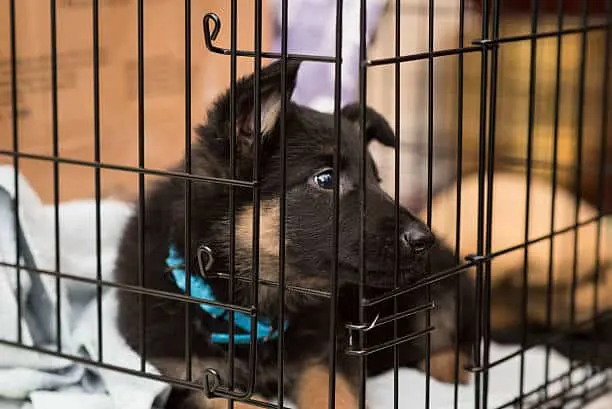
What are 8 things a crate should not do?
- A crate cannot be your pup’s companion or give her attention
- Crates do not provide your puppy with exercise or entertainment
- A crate does not substitute for training or socialization
- A crate is not a babysitter – You should not leave your dog alone in a crate for longer than eight hours in a session, and extended periods should not occur multiple times in a day.
- Do not use a crate to punish your puppy
- Do not cover your pup’s crate to punish her
- Do not allow your puppy to remain unattended in her crate when she demonstrates obvious signs of distress – i.e., biting the kennel where she could injure herself or crying inconsolably
- If your puppy is not in distress but just wants out, ignore his whining. If you want to crate train your dog properly, allow him to adjust.
When Will My Puppy Be Ready To Sleep Out Of The Crate?
It’s never a great idea to isolate a puppy away from the rest of its pack (or family members) during crate training.
When possible, keep them in a room with you so that they can feel your presence. This will keep them from feeling lonesome.
But after a few months of being with you and your family in their new home, you should be able to move them to a quieter room, where they can work on their independence.
At this point, they should be comfortable enough to realize that they no longer risk being left behind, and that this is their forever home.
Although some levels of separation anxiety will remain, and this is totally normal.
But by roughly 8 months of age, your dog should feel comfortable enough to sleep out of the crate.
But this will obviously depend on your comfort level as well.
If you still feel that your puppy may get up to no good during the night when left alone, then there’s no need to rush.
You are by no means obligated to close the crate door either. It can be left open so that your puppy can decide when and if they want to be in or out of it.
Summary – Important German Shepherd Puppy Crate Training Steps
1. Find a crate – Consider the size, material, and style
2. Introduce your new German Shepherd puppy to the crate – Spend time with your puppy around the kennel and place her inside at intervals with the door open initially
3. Pick a nighttime and daytime location for the crate
4. Accustom your puppy to spending the night in the crate – Place by your bed and set alarms to feed and take your puppy outside at set intervals. Duration lengthens as your puppy matures.
5. Prepare for training with a positive attitude – Ignore whining for attention but learn to recognize cries of distress (need to go outside, hungry)
6. Utilize one or more crate training methods and pick a command – Find what motivates your German Shepherd puppy, like food treats, toys, or games
Crate training your German Shepherd is a helpful skill that will last a lifetime, even if you discard the kennel after housebreaking.
A good rule of thumb, according to Cuteness.com, is to get rid of the crate when your puppy has managed to go for two months with no bathroom accidents.
Dispensing with a kennel can mean many things to different owners. You may never bring out the crate again unless your dog needs to board a flight.
Some people still feel more comfortable crating their German Shepherd when they leave for a few hours. Others like the idea that their German Shepherd still sleeps in the kennel as an adult.
A pet carrier can be a convenient place for owners to send their Shepherd if she is too protective around guests, if children are not behaving with appropriate pet etiquette, or if the house cleaning crew is working.
You may even give your German Shepherd the option to use her crate by leaving the door open at all times.
This video illustrates the consistent, repetitive, and rewarding approach you need to crate train your German Shepherd puppy properly.
The trainers are using a metal crate. One thing of note is that the kennel is a little short but accomplishes the goal of not allowing the pup to find a spot to use the bathroom.















